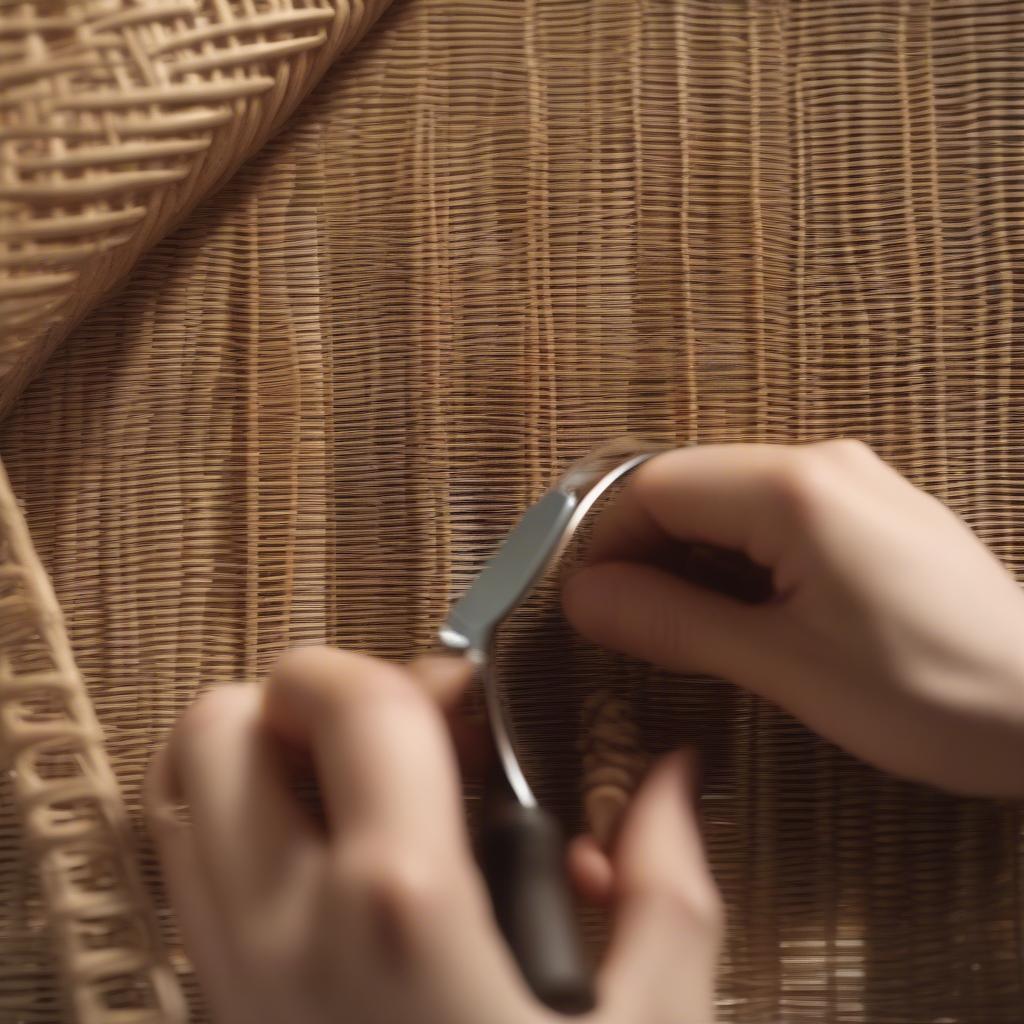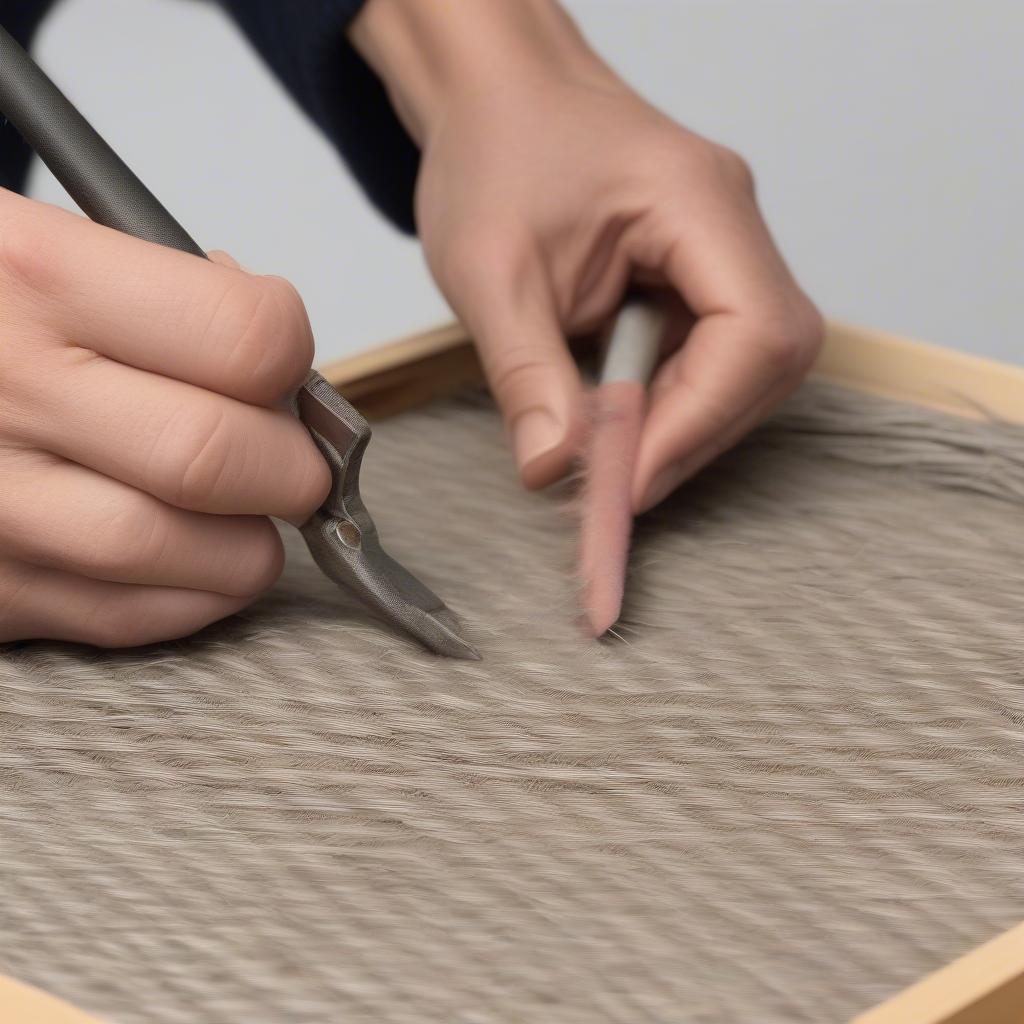Weave Table
How to Repair a Table That Weaves
Learning How To Repair A Table That Weaves can save you money and preserve a cherished piece of furniture. Whether your woven table is made of rattan, wicker, or another material, this guide provides comprehensive steps and expert tips to tackle common weaving repairs. We’ll explore everything from fixing minor breaks to addressing more substantial damage, ensuring your woven table regains its former glory.
Understanding Your Woven Table
Before diving into repairs, it’s crucial to identify the material of your woven table. Rattan and wicker are popular choices, but other materials like seagrass, bamboo, and synthetic fibers are also used. This knowledge helps determine the appropriate repair techniques and materials.  Identifying the Material of a Woven Table
Identifying the Material of a Woven Table
Identifying Rattan and Wicker
Rattan is a natural material derived from a climbing palm. It’s strong, flexible, and known for its smooth, solid core. Wicker, on the other hand, refers to the weaving process itself, and can utilize various materials, including rattan, willow, and synthetic fibers. Understanding this distinction is essential for effective repairs.
Common Woven Table Repairs
Woven tables, while durable, can suffer from various types of damage. Loose or broken weaves, frayed edges, and structural instability are common issues. Let’s explore how to address each of these:
Fixing Loose Weaves
For minor looseness, gently push the weaving back into place. You can use a blunt tool, like a butter knife, to help guide the material. For a more secure fix, use a small amount of wood glue to reinforce the connection.
Repairing Broken Weaves
 Replacing a Broken Weave on a Woven Table
Replacing a Broken Weave on a Woven Table
Replacing broken weaves requires finding a matching material. If you have spare material from the original construction, that’s ideal. Otherwise, try to source a close match in color and texture. Weave the new strand following the existing pattern, securing the ends with glue and small tacks if necessary.
Addressing Frayed Edges
Frayed edges can compromise the structural integrity and aesthetic appeal of your table. Trim frayed ends carefully with sharp scissors, and apply a sealant or edge binding to prevent further unraveling. This can be purchased at most craft stores.
Advanced Repair Techniques
Sometimes, woven tables require more extensive repairs. Here’s how to handle more significant damage:
Structural Reinforcement
If the frame of your table is wobbly or damaged, it’s crucial to address the underlying structural issues before repairing the weave. Tighten loose screws, reinforce joints with wood glue, or consider replacing damaged sections of the frame.
Complete Re-Weaving
outdoor table top waterproof cords weave
In cases of severe damage, complete re-weaving might be necessary. This is a complex process best left to experienced professionals, but with patience and attention to detail, it can be a rewarding DIY project. Start by carefully removing the existing weave, documenting the pattern as you go. Then, using new material, meticulously re-create the weave, ensuring consistent tension and spacing.
Preventing Future Damage
Regular maintenance can extend the life of your woven table and prevent future repairs. Keep it clean by dusting regularly and wiping with a damp cloth. Avoid placing hot items directly on the surface, and protect it from excessive moisture and sunlight. rattan and wicker weave side table rectangle
“Preventive care is key to maintaining the beauty and longevity of woven furniture,” says renowned furniture conservator, Amelia Cartwright. “Simple steps like regular dusting and protecting from the elements can significantly reduce the need for repairs.”
Conclusion
Knowing how to repair a table that weaves allows you to maintain and enjoy your furniture for years to come. Whether you’re tackling minor fixes or more complex restorations, remember to choose the right materials and techniques for your specific table. With a little patience and effort, you can restore your woven table to its original beauty and functionality.
FAQ
- What glue is best for repairing woven furniture?
- Where can I find replacement weaving materials?
- Can I paint my woven table?
- How do I clean a woven table?
- How can I prevent mold and mildew on my woven furniture?
- What is the difference between wicker and rattan?
- How much does it cost to have a woven table professionally repaired?
Common Scenarios:
- Loose weave: A single strand has become loose, causing a slight sag in the tabletop.
- Broken weave: One or more strands have snapped, creating a hole or gap in the weave.
- Frayed edges: The edges of the tabletop are unraveling, creating a rough or uneven surface.
- Wobbly legs: The legs of the table have become loose, causing instability.
- Structural damage: The frame of the table is cracked or broken.
Further Reading:
- Consider linking to articles on choosing the right outdoor furniture, caring for natural materials, and DIY furniture repair tips.
Contact us at Hotline: +84 388 951 999 or visit our offices in Hanoi, Vietnam or Tech Avenue, Suite 12, San Francisco, CA 94105, USA. We have a 24/7 customer service team.
